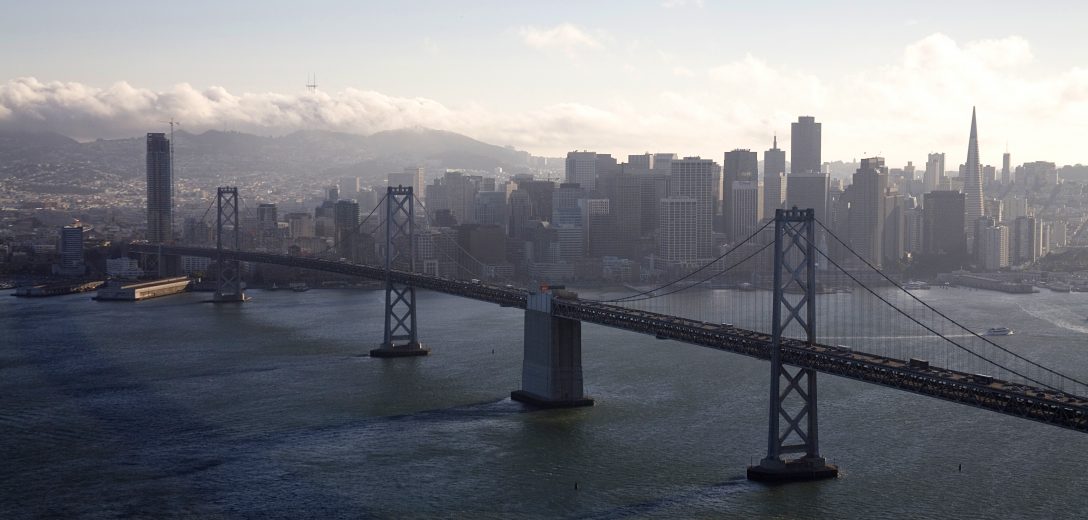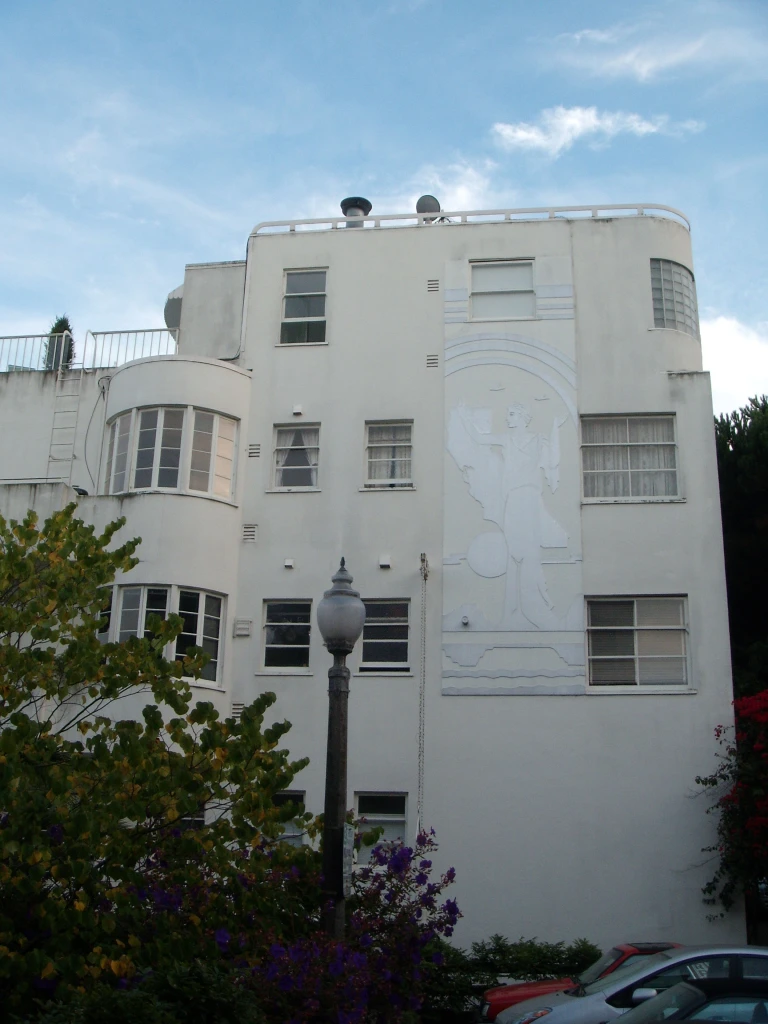
Rain has finally descended upon a parched San Francisco, casting a perfect gloomy backdrop just in time for this year’s Noir City Film Festival. Aficionados of the dark film genre are looking forward to this year’s program, where San Francisco plays a role in some of the films, starting tonight at the Castro Theatre. Both familiar and long-gone buildings and structures can be spotted in several films, where our fog-drizzled streets, covert alleys and stairways, and lust-inducing vistas make the city an excellent backdrop for murder, double-crosses, and ill-fated romance.
The festivities kick off with an old favorite, the 1947 film “Dark Passage,” starring Humphrey Bogart and Lauren Bacall. Bogart plays an ex-con on the run after escaping from San Quentin, where he was wrongly jailed for the murder of his wife. Enter Bacall, as Irene Jensen, who lets him hide for awhile at her chic San Francisco apartment on Telegraph Hill. The building her character lives in is one of the best examples of the Streamline Moderne style in the city, the Malloch Building. Streamline Moderne was the sleeker outgrowth of Art Deco that evolved in the 1930s, influenced by a variety of forces.
Look for glimpses of this still-stunning building if you see “Dark Passage” at Noir City X, or anytime you see the film. Completed in 1937, the Malloch Building has a bit of mystery of its own. It was featured in a six-page article in the December 1937 issue of Architect & Engineer, which oddly excluded the name of its architect, and only mentioned the owners/builders, father and son, John and J. Rolph Malloch, and consulting structural engineer, W.H. Ellison. But in the early 1980s, local author and historian extraordinaire Gray Brechin solved the mystery. Brechin discovered the building was designed by little-known local architect named Irvin Goldstine, whom he interviewed for an article in a New York magazine called Metro.
Brechin said that Goldstine did not have his architect’s license at the time he worked on the building, thus that explains why he is not listed as the architect of record. But while Goldstine eventually got his license in 1940, his work is not well known in the Bay Area, even though he designed many homes, apartment buildings and commercial structures in the Bay Area, according to architectural researcher Gary Goss. Brechin noted that while he was studying at the Ecole des Beaux-Arts in Paris, Goldstine was influenced by modernists like Le Corbusier and Erich Mendlesohn. The Malloch Building is a gorgeous example of Beaux-Arts planning infused with modern design and an embrace of art.
The wood-frame building is technically six stories from top to bottom, and Brechin noted that its owners were sued for violating a city ordinance that prohibits wooden-frame structures of over three floors above a garage. But because each floor is stepped and set back, there are no more than three floors at a time above the garage, and the Mallochs won their case.
The building, like many Streamline Moderne designs, is slightly evocative of a ship, as it sits perched at the top of the Filbert Steps, which Bogie trudges up in one scene in the movie. Other noteworthy features are its glass blocks, curvilinear lines, sand-blasted glass panels and three 40-foot high scraffito murals on the outside of the building. The then just-completed Bay Bridge is also featured in the mural shown here at the right. The murals, by artist Alfred du Pont, a friend of Goldstine’s, were made by applying colored concrete and carving it into shapes, a technique used in ancient Pompeii. Scraffito, derived from the Italian word for scratch, was also used on the murals that grace the sidewalls of architect Tim Pflueger’s Castro Theatre.
Originally built as an apartment house, all nine units and two penthouses were rented before the Malloch Building was completed, according to Architect & Engineer. “Telegraph Hill offers a certain Bohemian atmosphere that the public has found alluring and success of this particular venture has been an incentive for other investors to plan similar projects in this locality,” the journal wrote. In addition to the gorgeous views of the San Francisco Bay and the gleaming new bridge, tenants could also watch the building of Treasure Island and the Golden Gate International Exposition.

Residents enter via a street-level open garden vestibule, where the sand-blasted glass portrays leaping deer or gazelles and exotic foliage, stunningly backlit at night. Interiors were described as including circular dressing rooms, built-in bookcases, and glass brick partitions. Moldings, baseboards and other non-essentials were eliminated. The dining rooms were circular with open, built-in shelving and every apartment was painted boldly in a different color scheme. Photos of the early interiors show planter boxes built into the glass brick windows, with diffused light shining through, a much sleeker, modern interior than was portrayed in “Dark Passage” when it was filmed 10 years later.
Other venues to watch for in some of the Noir City films include a harrowing drive around Telegraph and Russian Hills and the grounds of the now-shuttered Julius Castle in Friday’s “The House on Telegraph Hill,” a 1951 film. The 1949 “Thieves’ Highway,” was shot in and around the former produce district, which was demolished for Embarcadero Center, and contains some of the best footage of that old market. Alcatraz and Fort Point both make an appearance in “Point Blank” a 1967 film about a man seeking revenge, starring Lee Marvin and Angie Dickinson. In a special treat, Dickinson will appear Saturday night for an interview on stage with the “Czar of Noir,” festival host, film preservationist and author Eddie Muller. The festival concludes with Bogart, playing the private eye, Sam Spade, in the 1941 version of “The Maltese Falcon.” A key scene in Dashiell Hammett’s 1930 novel takes place on Burritt, the dead-end alley off Bush St., down the block from the alley now known as Timothy Pflueger Place.
The modern elegance of 1360 Montgomery will likely outshine some of the other grittier locations seen in this festival. But there’s a lot to see over the next 10 days, including some long-lost vintage views of San Francisco.
And don’t forget to watch your back!



For a time (possibly still) a cardboard cutout figure of Humphrey Bogart appeared in a window of the Malloch building.
Your style is so unique compared to other folks I’ve read stuff from.
I appreciate you for posting when you have the opportunity,
Guess I’ll just bookmark this blog.
[…] Timothy Pflueger Blog […]
I have both seen this building in “Dark Passage” and seen it in person (in the 80s…the exterior, anyway) It is one of San Francisco’s best of the smaller Moderne gems, in my opinion.